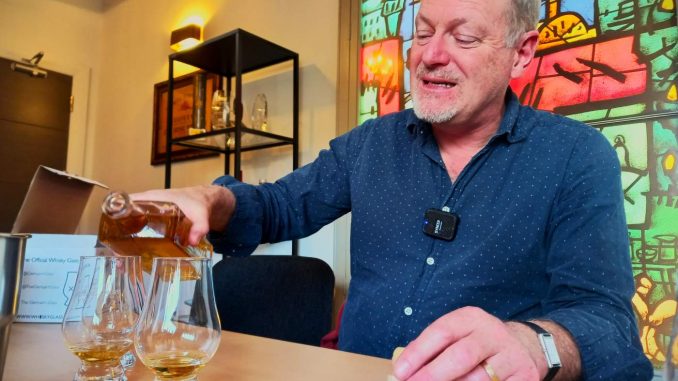
(Note from the author: This is a automated translation of the original German article)
„Welcome to Blackwater Towers,“ Peter Mulryan greets us in the
entrance to his distillery. „Us“ being my podcast partner Jason
and myself. In June 2022, while Jason was touring Ireland, we met
in the south of the Emerald Isle to tour whiskey distilleries
together. So on that sunny Thursday afternoon, we stood in
Peter’s Blackwater Distillery, expectant to learn more about the
small distillery.
The Blackwater Distillery is located in the small village of
Ballyduff in the west of County Waterford. The river Blackwater,
which gives its name to the distillery and is one of the longer
rivers in Ireland, flows through the village. Its source lies in
the border area of Kerry and Limerick. From there, it travels 169
kilometers to its mouth in the Celtic Sea at Youghal in County
Cork. Along its course, anglers enjoy its rich salmon stocks.
As tranquil as the water of the river ripples here under the
bridge outside the center of Ballyduff, so does the entire
village scenery. The few houses in the village center crowd onto
two narrow streets. One of them is this typical Irish country
road and follows the course of the river from Fermoy in the west
to Lismore in the east. The second country road connects the
aforementioned road with the main highway, a few kilometers to
the south. The intersection of the two forms the town center and
one of the buildings at that intersection is the Blackwater
Distillery of Peter Mulryan.
A visit to Peter Mulryan at Blackwater Distillery
The interior of the distillery is exceptional. The bright main
room is open on two floors. A kind of circulation leads around
the main room on the second floor. Up there is a cozy sitting
area with sofas and small tables. A lot of wood is used here. The
typical feeling of exploring a distillery does not arise
immediately. The ambience is too homely.
Finally, the view drops down to the firing apparatus on
the first floor. The sight of the technology brings the reality of
a production facility back to the surface.
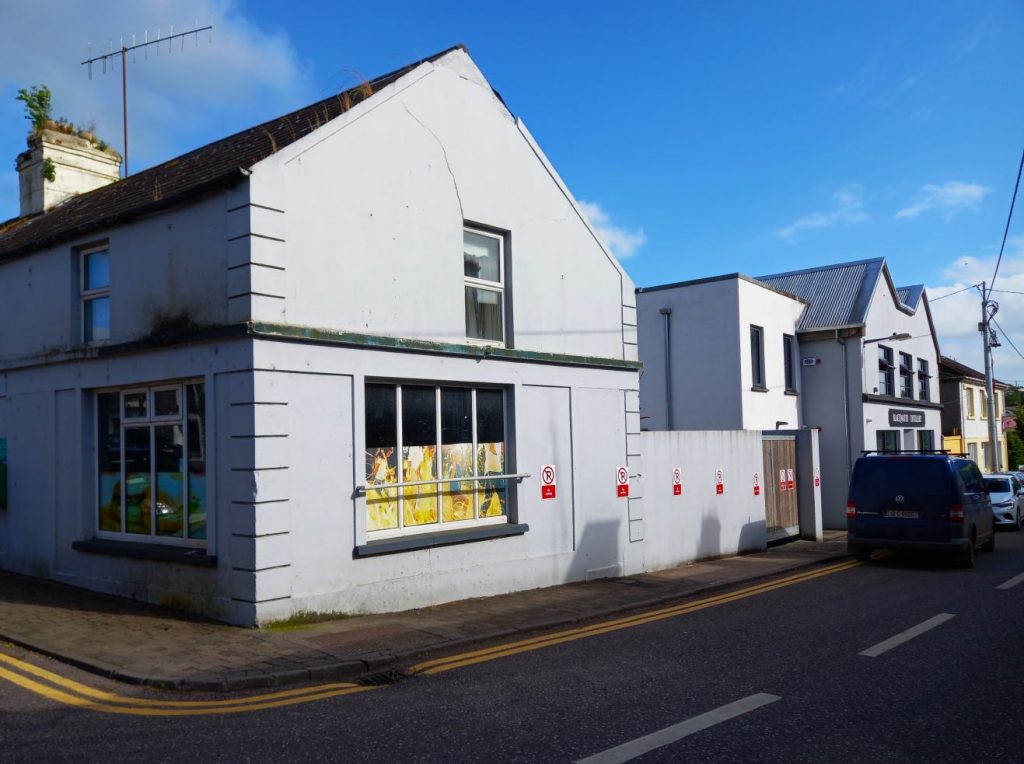
„Actually, these are three buildings,“ Peter Mulryan explains.
„The main building here used to be the local hardware store. That
closed in 2007. From here, it goes next door to our service
building. In there are offices, restrooms and such. And finally,
next door is a corner building. It currently looks like shit,“
Peter laughs at his direct choice of words.
„This used to be the village store. However, next summer, that
will be our tasting room.“
Peter leads us to a meeting room on the upper floor. The room is
bright, but simply furnished. Even a little untidy. Various
objects, bottles, glasses, stand on the cabinets and the
windowsill. The visual highlight is a large, stained glass window
on the inside wall. We sit down at a table in the middle of the
room. Peter asks us for coffee.
As he prepares our drinks, he explains, „We have two coffee
makers. One is mine, the other is John’s.“ This John is the U.S.
head distiller John Wilcox. We saw him as we came in, standing on
a small platform behind the still. A burly man with a dark beard,
tattooed arms and wool cap.
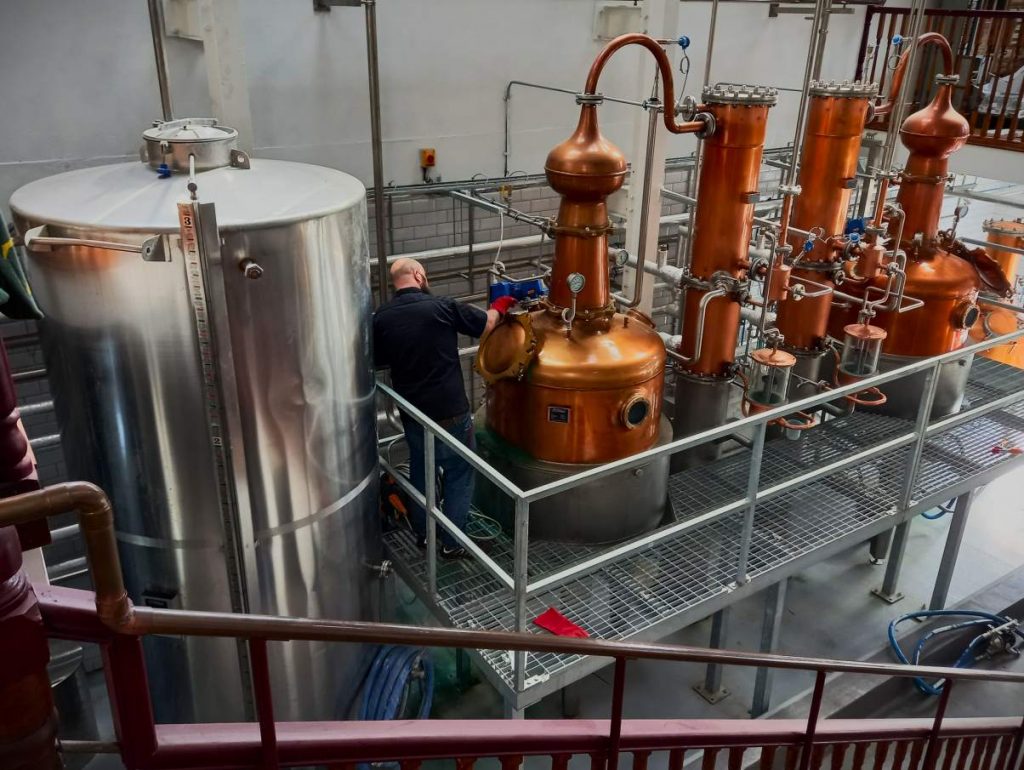
„It is all about taste!“
Why two coffee machines? „It’s always about taste, isn’t it?“
continues Peter. „One person prefers something one way, the next
person prefers it another way. That’s why I say never, really
never trust a distillery that offers you instant coffee.“ With a
sly smile, Peter brings our coffees to the table and sits down.
Peter Mulryan is an agile man in his prime. He came to whiskey
through a curious situation. „In the 1990s, I was a TV producer
living in London. A whole life it is
ago, I was on a boat in Greece. We were shooting a documentary
about wines and one of the greatest wine experts in Greece was on
board. One of his parents came from Ireland and so we drank Irish
whiskey below deck in the evenings. I had no idea about whiskey
at the time, but that’s how I got a taste for it,“ he continues.
Later, I went to a popular whiskey bar in Scotland. The waiter
there knew a lot and I learned from him how big the world of
whiskeys really is. That made a lasting impression on me.“
Peter Mulryan wanted to learn more and set out to find out:
„I was looking for books on whiskey. Especially Irish whiskey. I
didn’t understand why there was so much whiskey in Scotland and
not here. After all, the two countries are almost identical.“ The
result of his search was sobering. Says Peter, „There were
umpteen books on Scotch. On Irish whiskey, I found only a 1974
work by McGuire and a little guide Jim Murray had just written.“
Both books, however, led to Peter’s curiosity growing.
From TV producer to Blackwater Distillery
In the years that followed, Peter became extensively involved
with whiskey while continuing to work as a successful TV
producer. He learned about Irish whiskey history, especially from
talking to people in the whiskey industry. Finally, in 2002 his
own book was published. With „The Whiskeys of Ireland,“ Peter
Mulryan brought a summary of the whiskey history of the Emerald
Isle to the market. The book is now considered a standard work on
Irish whiskey. In 2008, he followed it up with a book about the
Bushmills Distillery. Peter had fully arrived in the world of
whiskey.
Now his next step seems logical: the change from the
TV producers to their own distillery. This journey officially
began in 2014, when Peter was again on the lookout. This time, he
was looking for the right location for a distillery. This he
finally found in the rural part of Waterford. „We talk about
West Waterford. It doesn’t get much more rural than this. There
are cows, barley, oats, horses, tractors. But no industry or
commercial space.“ In fact, there were only two properties in all
to choose from. One was in Cappoquin, another village on the
Blackwater River.
Gin and whiskey from West Waterford
Here he built a small gin distillery. Why,
despite all the odds, did he choose
Waterford? „I didn’t want to go to Cork. There were already
distilleries there with Midleton and West Cork. What’s more, we
were the first to want to distill in Waterford. The county
administration was correspondingly positive about our plans. We
received a lot of support from there.“ The model was the Dingle
Distillery, which had started operations two years earlier. In the
west of Kerry, gin was running successfully and thus formed an
important foundation for the production of whiskey.
Peter followed this logic. His gin was his first source of money.
With the proceeds and his private capital, he financed his next
project in 2018: his own whiskey distillery. In the process, he
encountered the same problem as four years earlier: no available
commercial space. So he ultimately came to Ballyduff and moved
into the vacant village hardware store. Peter, who was eager to
learn, had acquired knowledge about the operation of a distillery
and distillation. For this purpose, his path led him to Scotland
again. In an exchange with the Scottish Craft Distillers
Association, he spent some time on the neighboring island. There
he learned many things that were now useful to him. Nevertheless,
he was missing the most important thing: the distilling equipment.
The Pot Stills
Peter Mulryan got to those with a little help. „I got a call from
John Teeling. He told me to fly immediately to Italy to Frilli.
There were two stills there for me.
I went there and was shown two used grappa stills, each with a
capacity of 1,200 liters. They had been reconditioned, were very
cheap and were now waiting for a buyer,“ Peter reports. And he
continues: „When you install stills, you know at the
beginning anyway, what kind of fire will actually come out in the
end. There is always some risk involved. That’s why I struck.“
Thus, two used grappa pot stills moved into the Blackwater
Distillery. „And we were lucky: The raw spirit we made on a test
basis at the beginning was very good,“ says Peter, looking back on
the start with satisfaction.
Mixed Grains: The definition of Pot Still Whiskey
Already at the beginning of production, Head Distiller John Wilcox
had come to Ireland from the USA. Another good move by Peter
Mulryan. Because when Peter starts talking about the profile of
his whiskeys, John seems like the perfect man at the production
helm. „Our focus is on the grain,“ Peter explains. „We process not
only barley, but also oats, rye and wheat. Malted as well as
unmalted. Sometimes peated. And in our mashbills, we combine all
of that.“ A look at John Wilcox’s resume now shows the
similarities. For John has been working for various craft
distilleries in the USA as a distiller and consultant since 2010.
His focus: craft whiskeys made from different grains.
Where did Peter’s concept for these mixed mashbills, or mixed
grain whiskeys as he himself calls them, come from? Here we come
full circle to Peter’s early days as a whiskey enthusiast and
history buff. „Pot Sill Whiskey was once not what we are told
today. All this nonsense about malted barley and unmalted barley.
What actually „traditional“ pot still whiskey was, has been written out of
history in recent decades by the big ones of the industry. Namely, a
variety of different cereals. Especially oats. And we’re not
talking about the current legal maximum of five percent. We’re
talking about 20 to 30 percent. We’re bringing back this true
tradition,“ Peter tells us emotionally.
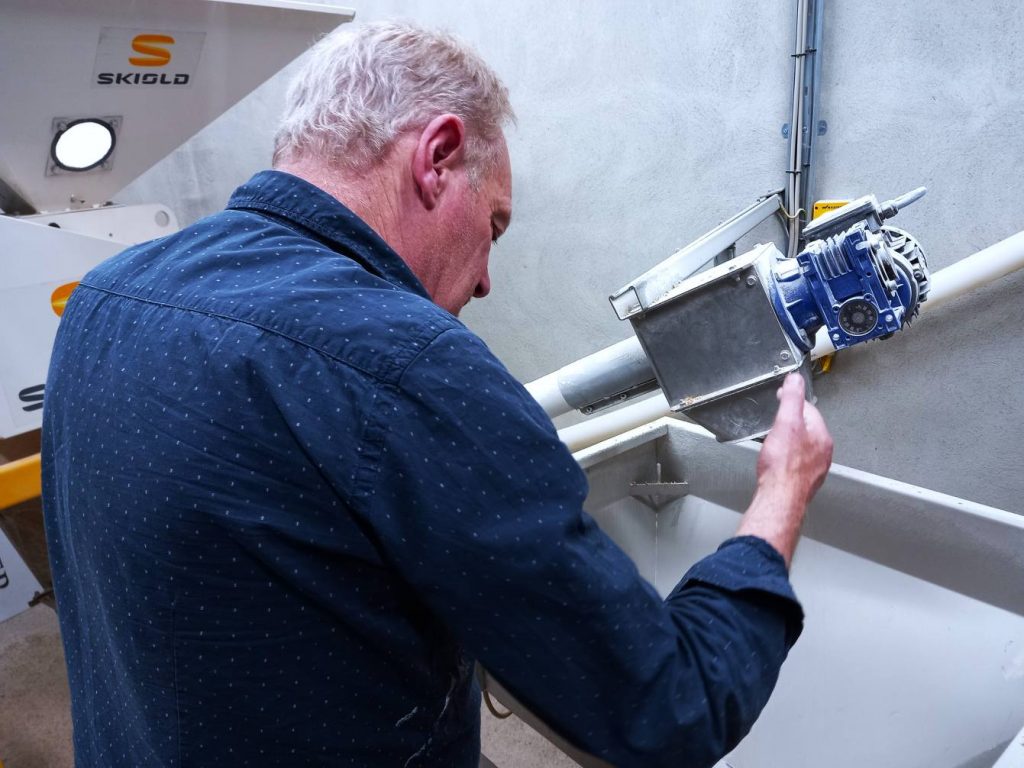
Historical mashbills
Peter Mulryan can back up his words with numerous, historic
distilling recipes that he and many others have written in the
researched over the past few years. For this purpose, we stand
downstairs in the Stillhouse in front of a small desk. Above it,
copies of old texts hang on a bulletin board. „These are the
documents that were found in books and records. Old recipes that
were actually used for distilling. Like here at Bandon Distillery
in the
19th century,“ Peter explains, pointing to the documents. „And
they all contain other grains besides barley.“ For his own
mashbills today, Peter uses common grains such as Laureate barley
or Husky oats. However, he’s looking to the past here, too. That’s
why distillates made from historic barley varieties such as
Hunter, Goldthorpe and Old Irish are already waiting in the wings.
„The differences in taste due to the different varieties, are
extraordinary,“ Peter notes.
The focus lies on the grains
Peter sources both his raw grain and his malt locally. This comes
from two small Irish malt houses. Including peated malt.
„Initially, like everyone in Ireland, we got our peated malt from
Scotland. But now smaller quantities are also available from local
production,“ he elaborates. In the first production step, a roller
mill crushes the grain into a kind of flour. Peter Mulryan
comments: „This is actually unfavorable. For pot still
distillation, a hammer mill would be better because it leaves a
coarser grain.“
Subsequently, brewing takes place in batches of 500 kilograms.
Peter points to the mashtun. A green glass plate with an engraved
sculpture hangs from a steel beam. „That’s Sheila,“ Peter says.
The figure becomes recognizable as Sheela-na-gig, a medieval
depiction of a female demonstrably showing off her vulva. „Sheela
is the mother. In our country, it’s not the pot stills that have
names, it’s the mashtun. The origin. The place where whiskey is
born.“ That birthing process – brewing – uses a standard yeast. To
the frustration of Head Distiller John Wilcox. „John is used to
the wide range of yeast varieties available in the U.S. and gets
here in Europe hardly what he would like,“ smiles Peter. „But
we’re working on that,“ he promises.
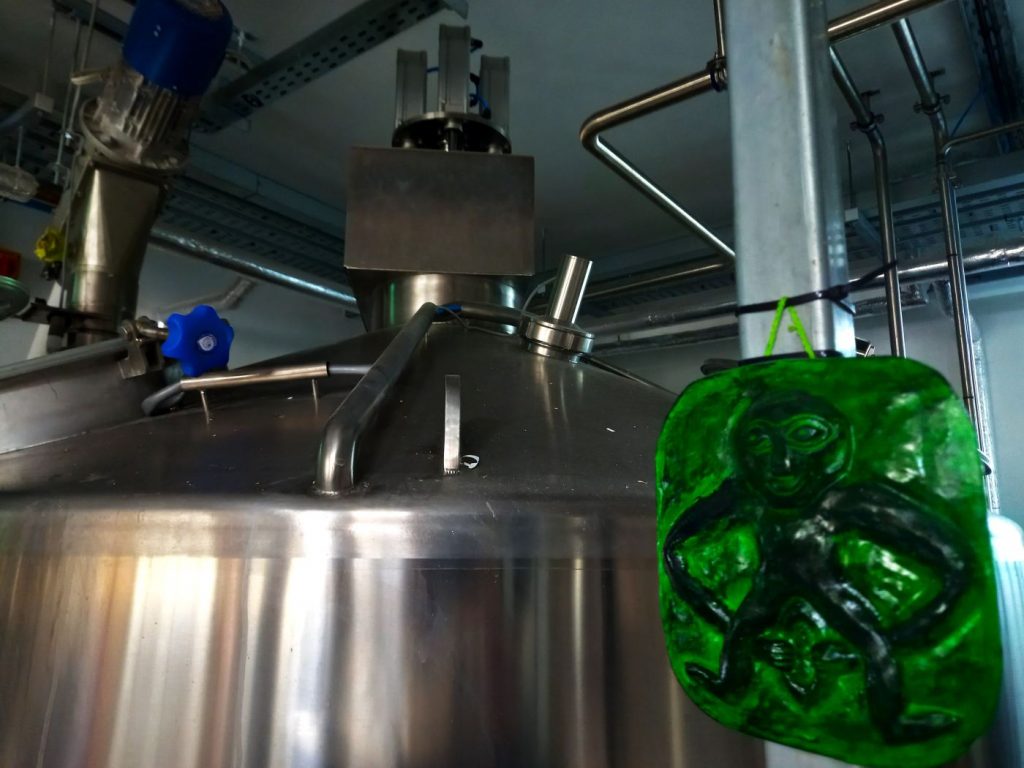
The whiskey distillation
We walk over to the pot stills and Peter explains the whiskey
distillation process at Blackwater Distillery: „We only double
distill. Triple distillation increases the proportion of ethanols
and that reduces the influence from the grain.
That’s exactly what we don’t want.“ After two distillation runs,
the collected alcohol has a strength of 69 percent. It is blended
with water and poured into the barrel at 63.5 percent alcohol
volume. „John works with two distillers five days a week on a
single shift. Theoretically, this allows for three barrels per
day,“ Peter knows. In fact, the alcohol ends up in a large 1,000-
liter container. When this is full, the contents are filled into
five standard barrels, which thus make up a batch.
In doing so, Peter and John invested the early days of Blackwater
Distillery in experimenting with historic mashbills. „To start, we
thought we’d do something boring first: a single malt.“ Peter
laughs. „Then we distilled a single pot still. Completely
compliant with the law. We divided the permitted five percent into
oats, rye and wheat. And from the third distillation on, nothing
emerged that would meet the legal requirements for pot still
whiskey.“
Peter leads us to a single whiskey barrel at the edge of the room.
It stands between brooms and empty containers. Two pairs of rubber
gloves lie on top. „This is our very first barrel of whiskey. Many
distilleries display this on a wall. We store rubber gloves on it,“ he laughs.
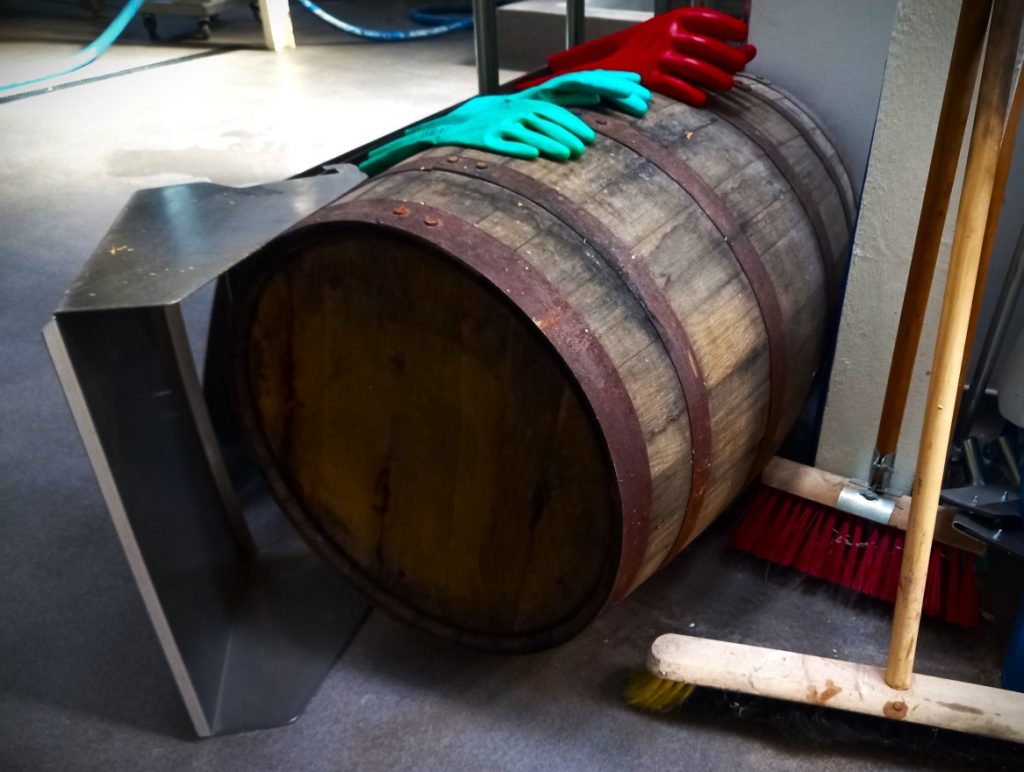
Mixed Grains: Historical mashbills with a modern touch
Still, Peter Mulryan doesn’t want to simply recreate historical
whiskeys. „This is not a history experiment. We want to give pot
still whiskey back its true flavors. But at the same time,
develop our own style,“ he says seriously. Peter names a good
example of this experimentation as Oaty McOatface. „For Oaty
McOatface, we used three kinds of oats. The distillate tastes
odd. Lovely! But really odd,“ Peter laughs again.
For the perfect, own touch Peter is again on the search. This time
in search of the perfect barrel for the recipe in question. To
this end, he explains, „We know that each type of grain works
particularly well with certain barrels. That’s why Redbreast is so
successful with sherry barrels. Because unmalted barley goes very
well with the sherry notes.“
Cask management
But Peter Mulryan doesn’t think much of long barrel storage: „If
you produce inexpensive raw spirits in large quantities, then good
and long barrel storage is important. Because this then makes up
the bulk of the character of the finished product. But we don’t
make sheer units of alcohol. We make whiskey. And our distillate
should show the character of the grain. The barrel should
emphasize this, not determine the overall product.“
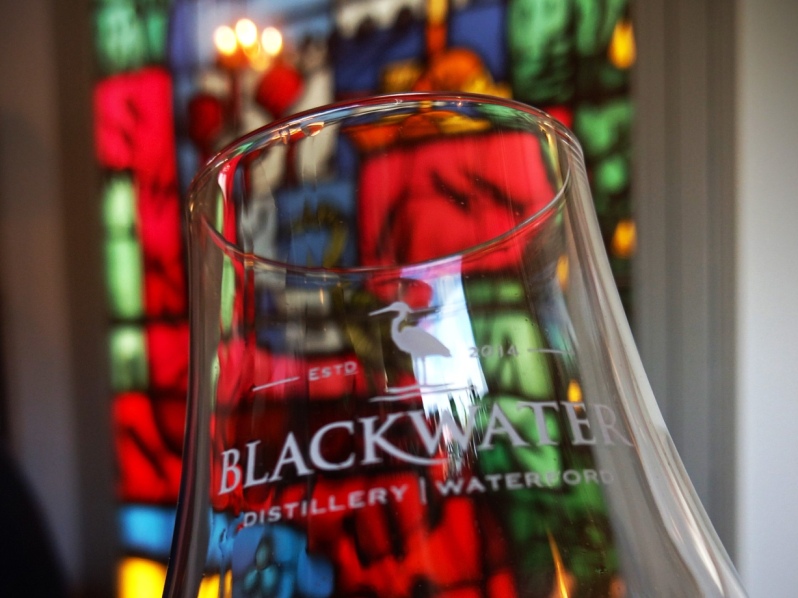
Peter is well aware that this goes against everything whiskey
drinkers have been saying about their favorite spirit. Also that
his whiskeys can therefore be controversial. „We’re going on an adventure of
taste. And I know we’re going to overwhelm some people
with it. That’s okay. For those who want boring, there are already
lots of other whiskeys out there.“
His first releases on the taste adventure journey followed in
December 2022. With Dirtgrain Mainfesto appeared four whiskeys
distilled from mashbills of the last 185 years. Fittingly for the
author Peter with a booklet in which he explains his definition of
pot still whiskey. While whiskey connoisseurs can now taste the
first bottlings, Peter diligently continues to experiment and plan
for the future. In the future, the Blackwater Distillery’s adventure of taste
will continue beyond whiskey. The gin distillery in
Cappoquin is moving to a larger location during 2023. Whether
Peter is successful with his definition of pot still whiskey and
will eventually have to go back on the search to find a larger
location, that future will show.
